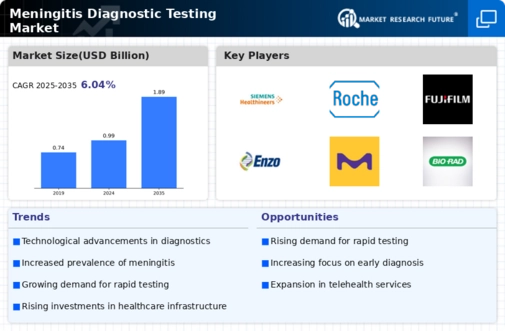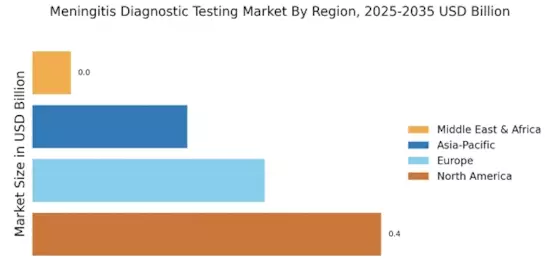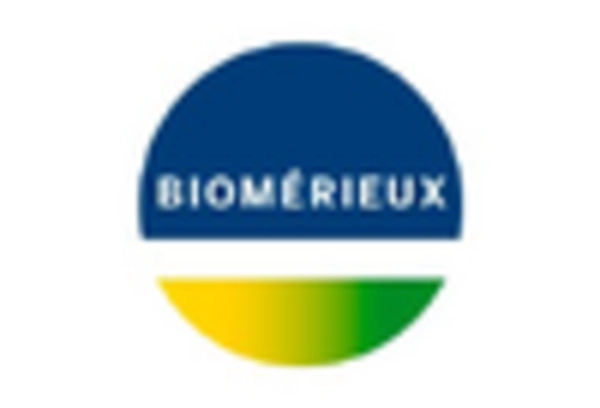Rising Incidence of Meningitis
The increasing incidence of meningitis cases is a primary driver for the Meningitis Diagnostic Testing Market. Reports indicate that bacterial meningitis remains a critical health concern, with an estimated 1.2 million cases occurring annually worldwide. This rising prevalence necessitates the development and implementation of effective diagnostic testing methods. As healthcare providers strive to improve patient outcomes, the demand for rapid and accurate diagnostic tools is likely to surge. Furthermore, the emergence of new strains of pathogens may contribute to the complexity of diagnosis, thereby amplifying the need for advanced testing solutions. Consequently, the Meningitis Diagnostic Testing Market is poised for growth as healthcare systems adapt to these challenges.
Government Initiatives and Funding
Government initiatives aimed at combating infectious diseases are playing a pivotal role in shaping the Meningitis Diagnostic Testing Market. Various health organizations and governmental bodies are allocating substantial funding towards research and development of meningitis diagnostics. For instance, initiatives to enhance surveillance systems and improve access to diagnostic testing in underserved regions are gaining traction. Such efforts not only aim to reduce the burden of meningitis but also stimulate market growth by fostering innovation in diagnostic technologies. The financial support from governments is likely to encourage collaborations between public and private sectors, further propelling advancements in the Meningitis Diagnostic Testing Market.
Technological Innovations in Testing
Technological advancements in diagnostic testing are significantly influencing the Meningitis Diagnostic Testing Market. Innovations such as polymerase chain reaction (PCR) and next-generation sequencing (NGS) have revolutionized the speed and accuracy of meningitis diagnosis. These technologies enable the detection of pathogens with high sensitivity and specificity, which is crucial for timely treatment. The market is witnessing an influx of novel diagnostic kits that leverage these technologies, enhancing the overall testing landscape. As healthcare providers increasingly adopt these advanced methodologies, the Meningitis Diagnostic Testing Market is expected to expand, driven by the demand for more efficient and reliable diagnostic solutions.
Growing Demand for Point-of-Care Testing
The increasing demand for point-of-care (POC) testing is emerging as a significant driver for the Meningitis Diagnostic Testing Market. POC testing offers rapid results, enabling healthcare providers to make timely decisions regarding treatment. This is particularly crucial in cases of meningitis, where delays in diagnosis can lead to severe complications. The convenience and efficiency of POC testing are appealing to both healthcare professionals and patients, leading to a shift in diagnostic practices. As more healthcare facilities adopt POC testing solutions, the Meningitis Diagnostic Testing Market is likely to experience substantial growth, reflecting the changing landscape of diagnostic methodologies.
Rising Awareness of Meningitis Vaccination
The growing awareness surrounding meningitis vaccination is influencing the Meningitis Diagnostic Testing Market. As public health campaigns emphasize the importance of vaccination, there is a corresponding increase in the demand for diagnostic testing to monitor vaccine efficacy and detect breakthrough infections. This heightened awareness not only drives vaccination rates but also necessitates robust diagnostic solutions to ensure effective disease management. Consequently, the Meningitis Diagnostic Testing Market is expected to benefit from this trend, as healthcare providers seek to implement comprehensive testing strategies that align with vaccination efforts.


















Leave a Comment